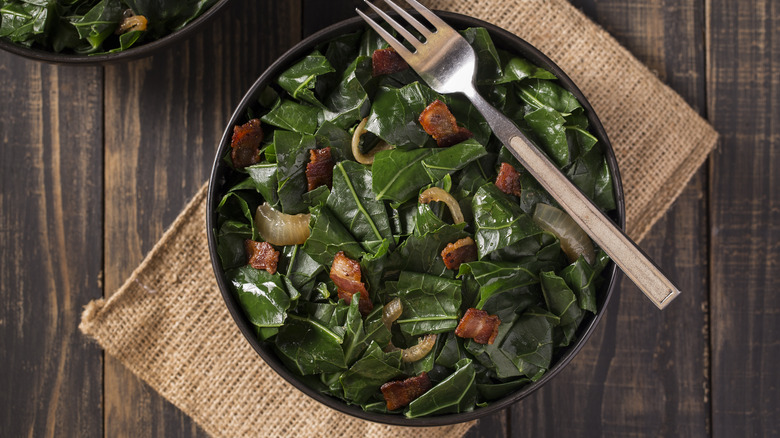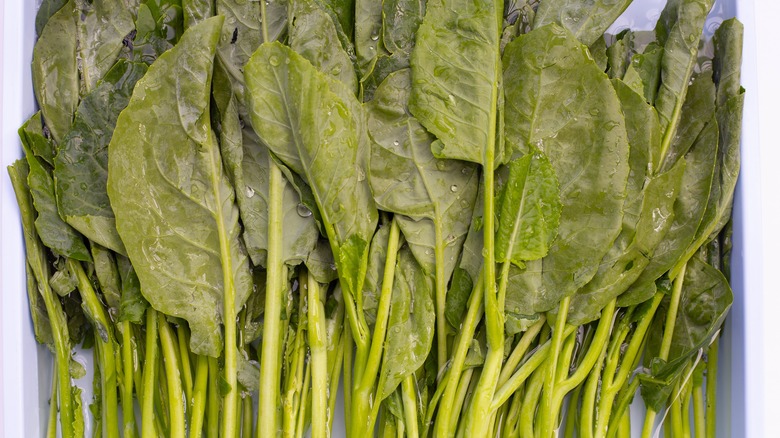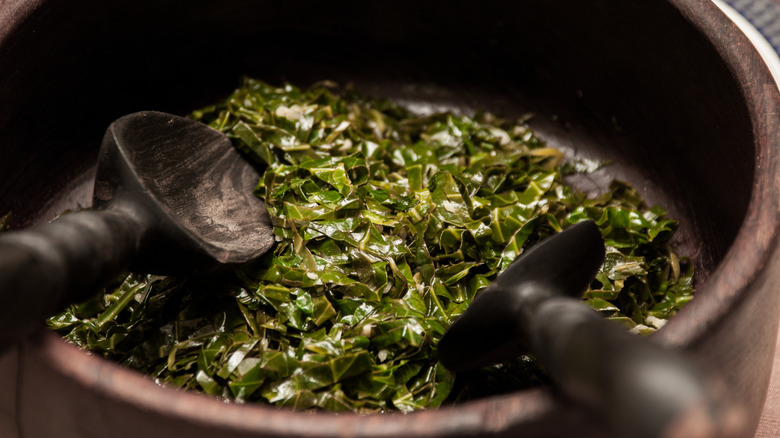How To Clean Collard Greens To Use In A Perfect Holiday Side Dish
Any Southerner will tell you that a "mess" of collard greens, braised with onion, pork side meat, red pepper flakes, and a pinch or two of sugar and salt, is utterly divine. (You should add vinegar to this list of ingredients too: either the apple cider kind in the braise or balsamic as a garnish if you're feeling fancy.) Beyond that, this cooking process produces a value-added "by product" called pot liquor which is an absolute superfood, containing in its umami deliciousness an amazing concentration of nutrients, minerals, and vitamins. But the most important step in making collard greens — no matter which recipe you prefer — is cleaning them properly. If this part is not done correctly, your holiday dish will be fatally flawed.
Collards, like all robust greens, need a good soak and a careful rinse. That's because freshly-picked collard greens — especially those that are commercially grown — can be wearing all kinds of unappetizing things, from dirt to insects to pesticide residue. It's vital to remove these contaminants from the collards before stemming, chopping, and putting them in the pot. You'll be happy to know that the bulk of time needed for accomplishing this cleansing task mostly involves leaving the collards alone during their spa time.
The right way to clean collards
Every reputable source (as well as generational experience) counsels you to soak the greens in water for at least 10 minutes, preferably 15. You can do this in a bowl, but it's better done in the sink filled with clean, cold water (hot water will wilt the greens prematurely). It's preferable to use the sink because the sand and silt washed from the leaves will sink to the bottom, and you'll want several inches of room for them to get clear of the produce. For this reason, pluck the collards out of the soak with your hands prior to draining the sink. As you do this, rinse each leaf individually to make sure all the dirt and debris have been removed.
Some people swear by adding a little salt to the soak — and it has been shown that a salt scrub does help remove dirt. Others clean their collards with vinegar, but you can save that for the dish itself. Whatever you do, never, ever use dish soap or laundry detergent to clean your collards. The slightest residue of that stuff can make you sick. Also: yuck.
Choosing the best collard greens
If you're going to go to all the (necessary) trouble of cleaning collard greens, it's best to know how to choose them wisely when buying them in the first place. The general rule of thumb to use is if they look good, they'll taste good. This means finding collards that are fresh and uniformly green. If you come across a bunch of collard greens that are yellowed or spotted, pass them by — and this goes double for ones that are wilted or (ugh) slimy. You deserve good things.
So, now you know how to buy collard greens as well as how to clean them. How they're prepared is up to you. When cooked correctly, collards have a comforting, earthy taste and fulsome softness — ideal for a holiday table laden with roast meats and sweet potato soufflés. Collards are delicious cooked in the Southern style with bacon, or in the fragrant Ethiopian collard greens recipe, or in consort with other leafy friends like mustard and turnip greens, spinach, and beet tops in dishes like the Creole delicacy gumbo z'herbes.


